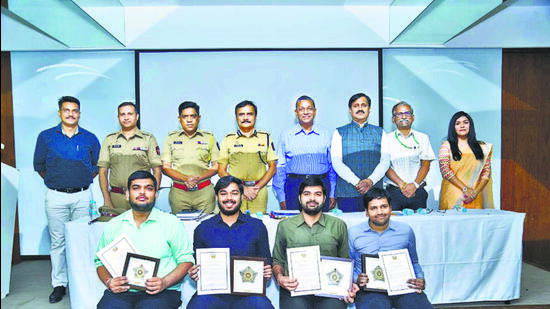How AI tools are helping Mumbai cops prevent crimes
The AI-powered predictive policing system, focusing on mobile theft, chain snatching and vehicle theft, was found to have a 75% accuracy rate
MUMBAI: In a collaborative effort between the K J Somaiya Institute of Technology, Mumbai, and the Mumbai police, two advanced tech solutions have been developed to enhance policing efficiency in the east region, which includes Zone 6 (Mulund to Ghatkopar)and Zone 7 (Shivaji Nagar to Sion), spanning 18 police stations and involving over 600 officers. These tools aim to address two key areas: crime prediction and charge sheet management.

The first of these is an AI-powered Predictive Policing System, built to forecast potential crime occurrences using historical data. During its pilot phase in March 2025, this system demonstrated a promising accuracy rate of 75%, helping prevent three incidents. It currently focuses on crimes such as mobile theft, motor vehicle theft, and chain-snatching.
Prof Radhika Kotecha, head, department of information technology, led the research. “The system performs crime pattern analysis and forecasting to support law enforcement in crime prevention and resource planning,” she explained. “It specifically targets mobile theft, suspected missing mobile cases, vehicle theft, and chain-snatching within Zones 6 and 7.”
The development team included final-year BTech students Hemanshu Rajde, Chirayu Agrawal, Dhruv Mokashe and Jatin Soneta along with a few junior contributors. Their work was backed by additional commissioner of police Mahesh Patil, and DCP Zone 6 Navnath Dhavale. The data collection was coordinated by PSI Rushikesh Babar with assistance from all local police stations.
Elaborating on the system’s working, Prof Kotecha said that the model was trained using five years of crime records. Through data preprocessing and the Haversine formula (used to calculate distances between locations), the system analyses spatial crime patterns. It then uses Hierarchical Density-Based Clustering, a machine learning technique, to identify crime hotspots and predict likely future incidents. Officers receive weekly reports highlighting probable crime types, locations and time windows along with monthly analytics summarising trends by area. These reports, available in PDF format, help optimise patrolling and deployment.
The inspiration for this initiative emerged during a February training session on AI conducted by Prof Kotecha for officers in the east region. A discussion with DCP Dhavale on using AI for crime forecasting sparked the idea, leading to the project’s rapid development. “It’s the commitment of our faculty and students that allowed us to build and test the system in just one month,” said Suresh Ukarande, director of the K J Somaiya School of Engineering.
Commenting on the outcome, additional CP Patil noted, “When deployed in real time last month, the system correctly predicted the locations of thefts within a 500-meter radius with 75–80% accuracy. It is proving to be a valuable tool for identifying high-risk areas. As more data becomes available, the system will only get better.”
According to institute data, the system showed a high degree of accuracy: 85.71% for motor vehicle theft, around 80% for mobile theft, and 77.16% for suspected mobile thefts.
A smarter way to track chargesheets
The second solution developed by the institute is the Chargesheet Submission Monitoring System (CSMS), designed to ensure timely chargesheet filing. Delays in submission often result in accused individuals being released on default bail. The use of CSMS can prevent this by keeping officers accountable and informed.
Prof Kotecha explained that this system supports officers across all 18 police stations in Zones 6 and 7. Over 600 personnel, including ACPs, zonal heads, station in-charges and investigating officers are expected to use it. The system allows users to log crime details such as FIR number, crime type, location, relevant sections and information. As deadlines approach, automated SMS reminders are sent to investigating officers, their station in-charges, and the ACP 25, 15, and 5 days before submission is due.
Additional CP Patil emphasised the practical value of the system. “We are using this mobile platform to stay on top of filing deadlines,” he said. “It also provides pendency reports by zone, station, officer and crime category, helping senior officers keep track of outstanding cases.”
Stay updated with all the Breaking News and Latest News from Mumbai. Click here for comprehensive coverage of top Cities including Bengaluru, Delhi, Hyderabad, and more across India along with Stay informed on the latest happenings in World News.
Stay updated with all the Breaking News and Latest News from Mumbai. Click here for comprehensive coverage of top Cities including Bengaluru, Delhi, Hyderabad, and more across India along with Stay informed on the latest happenings in World News.
All Access.
One Subscription.
Get 360° coverage—from daily headlines
to 100 year archives.



HT App & Website







